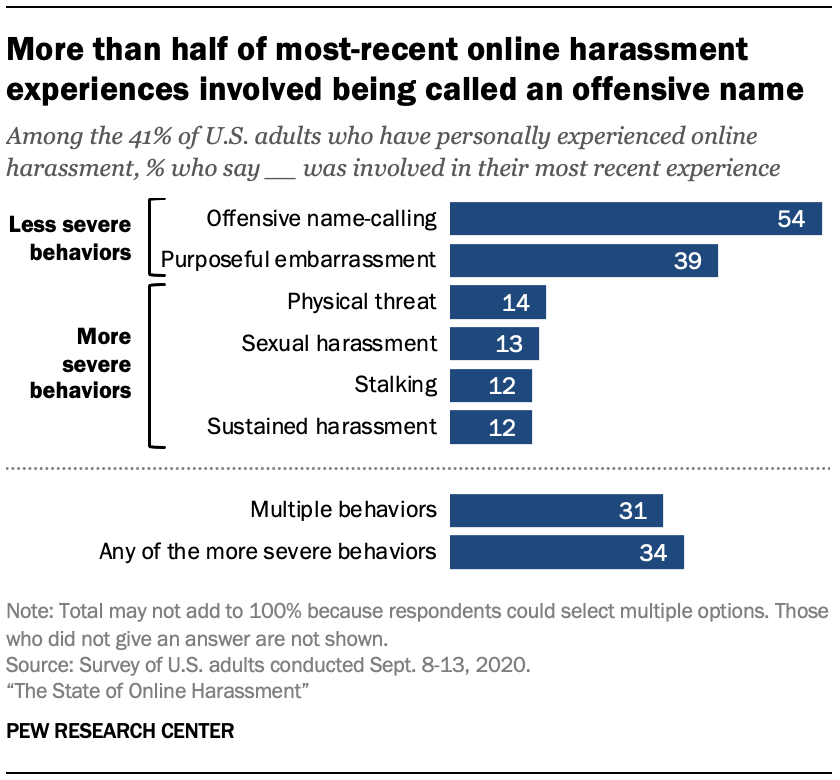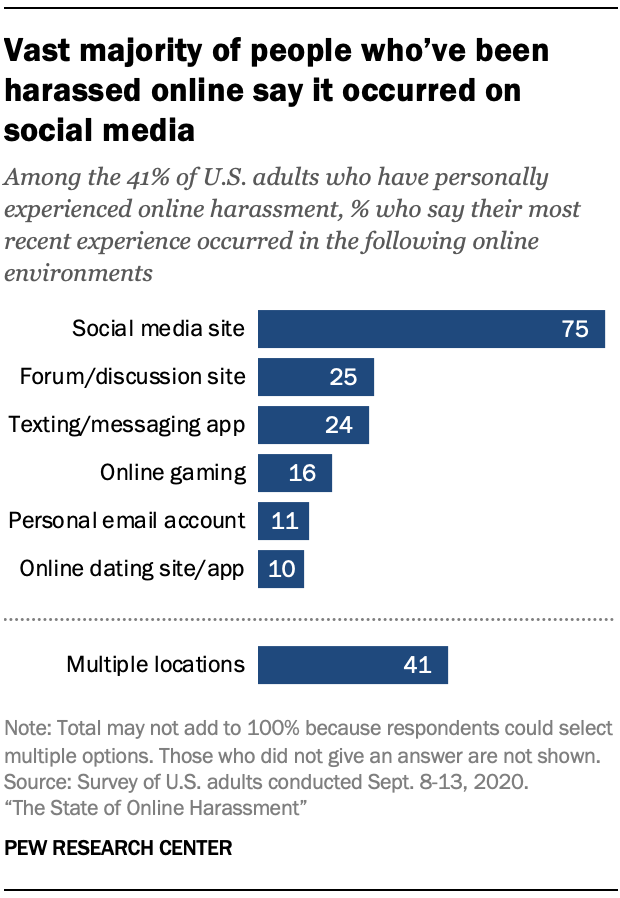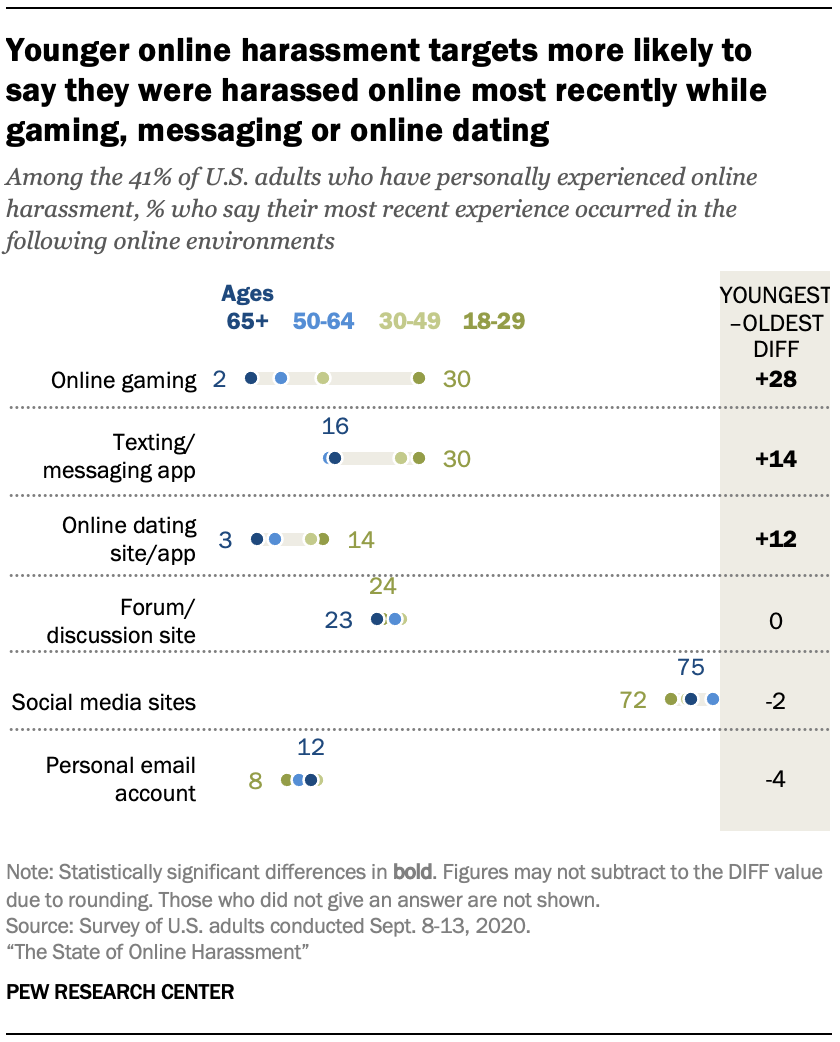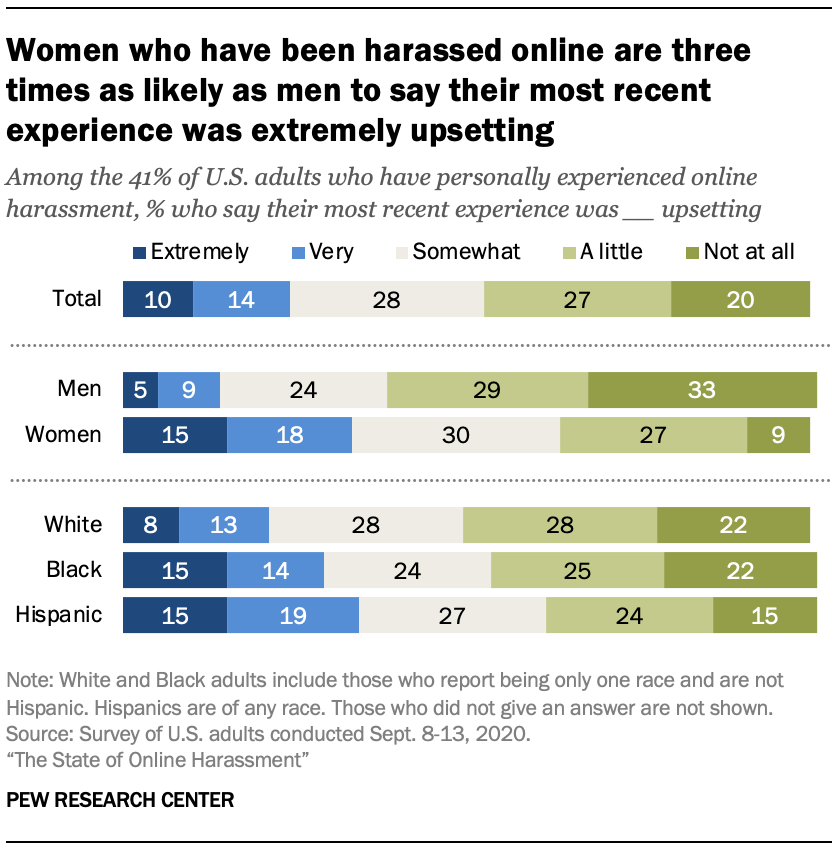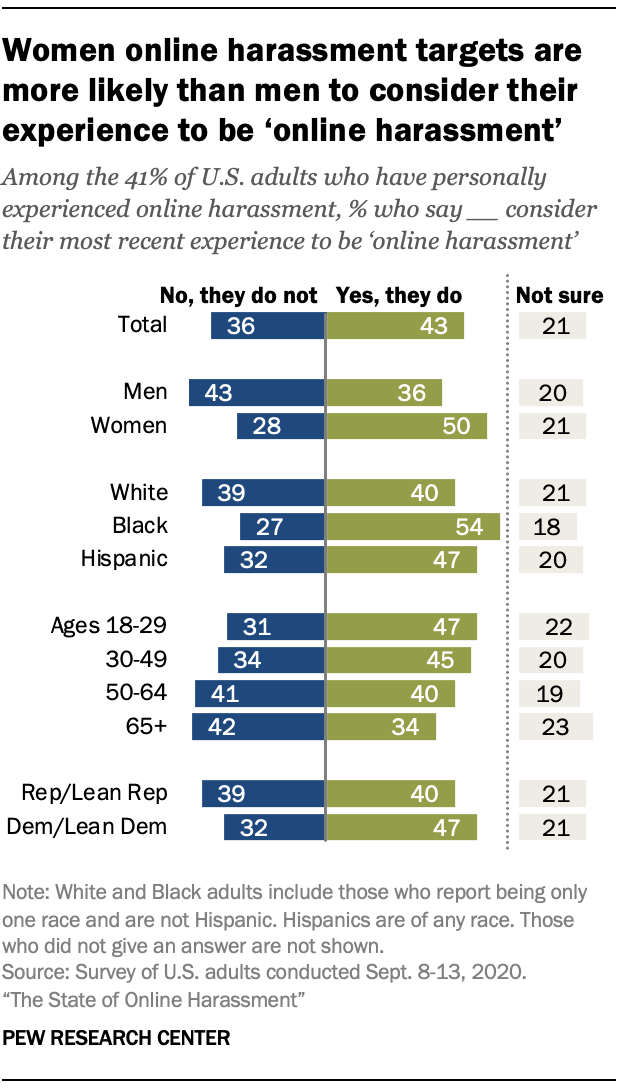In order to gain a more detailed understanding of the daily realities of online harassment, the 41% of adults who have been targeted online were asked a series of questions about their most recent experience. These questions cover everything from the behaviors involved to how upsetting they may have found the experience.
This new survey finds some similarities between the recent experiences now and those in the past. To begin with, social media sites remain the most common venue for this type of online abuse, while name-calling continues to be the most commonly reported form of online abuse. About a third say they experienced more severe behaviors or multiple harassing behaviors. Still, roughly a third say they do not consider what happened to them to be online harassment.
About a third of online harassment targets say their most recent experience involved more severe forms of harassment
Among the 41% of Americans who report ever being harassed online, 73% say their most recent experience involved at least one less severe behavior, while about a third (34%) report at least one of the more severe behaviors was involved in the most recent incident. About three-in-ten say their most recent experience involved two or more of the behaviors they were asked about.
Some 54% of adults who report having personally experienced online harassment say they were called an offensive name in their most recent experience, while 39% of this group reports being purposefully embarrassed. On the other hand, more severe behaviors – such as being physically threatened, sexually harassed, stalked or harassed for a sustained period of time – are less commonly cited as occurring in their most recent experience.
Among people who have been harassed online, adults under 30 years old (32%) are less likely than those in older age groups to say their most recent experience involved someone trying to intentionally embarrass them.

Conversely, younger online harassment targets are more likely to report their most recent experience involved more severe forms of harassment. Specifically, adults under 50 are more likely than adults 50 and older to say their most recent experience involved physical threats (17% vs. 8%), sexual harassment (16% vs. 7%) or stalking (15% vs. 6%). While similar shares of adults ages 18 to 29 and 30 to 49 report experiencing each of the more severe behaviors, adults 65 and older who have experienced online harassment differ from those 50 to 64 in being less likely to report encountering physical threats, stalking or sustained harassment in their most recent experience.
About six-in-ten White online harassment targets (57%) say they were called an offensive name in their most recent experience, compared with approximately half of Hispanic harassment targets (48%). Hispanic (20%) or Black (17%) adults who have experienced online harassment are about twice as likely as their White counterparts (9%) to say they were stalked in their most recent online harassment experience.
Social media sites are the most common location for online harassment
Three-quarters of Americans who have been the target of online harassment say that their most recent experience occurred on social media – making this the only venue measured in this survey that a majority cited as being a location where their most recent online abuse took place.
By comparison, roughly one-quarter of this group mentions online forums or discussion sites (25%) or texting or messaging apps (24%) as the location where their most recent experience occurred. Smaller shares say their most recent experience occurred during an online game, in their personal email account or on a dating site or app (10%). In total, 41% say their most recent experience of harassment spanned multiple platforms.
Looking back to 2017, most of these online spaces have seen an increase in people saying their most recent harassment occurred there. Social media are up 17 percentage points, and online forums or discussion sites are up 18 points since 2017. The share who say their most recent experience occurred on a texting or messaging app was up 10 points, from 15% in 2017 to 24% in 2020. Smaller increases were seen in the shares who mention online gaming (5 points) or dating sites or apps (5 points).
There are also some gender differences in where people report encountering this type of harassment in their most recent episode. While social media is the most commonly cited online space for both men and women to say they’ve been harassed, women who have been harassed online are more likely than men to say their most recent experience was on social media (a 13 percentage point gap). On the other hand, men are more likely to report their most recent experience was while using an online forum or discussion site or while online gaming (both with a 13-point gap).
There are no statistically significant differences by gender when it comes to being harassed via texting or messaging apps or in personal email accounts. Among adults under 35, women (12%) and men (13%) who have been harassed are equally likely to say their most recent harassment occurred on an online dating site or app. But when looking at harassed parties 35 and older, women are marginally more likely to have been harassed while online dating than their male counterparts (10% vs. 6%).
Younger adults who have been harassed online are also more to say their most recent encounter was while online gaming. Three-in-ten online harassment targets ages 18 to 29 say their most recent experience was while online gaming, compared with 14% of online harassment targets who are 30 to 49. Even smaller shares of targets ages 50 to 64 or 65 and older say the same.
Among adults who say they have faced online harassment in the past, adults under 50 are about twice as likely as those ages 50 to 64 to say their most recent experience was on an online dating site or app. This was the case for only 3% of online harassment targets 65 and older. In addition, adults under 50 who have faced online harassment are more likely to report that their most recent experience with online harassment took place on a texting or messaging app compared with adults 50 and older (28% vs. 15%).
Similarly, Black or Hispanic online harassment targets are more likely to report their most recent experience involved a texting or messaging app (31% and 34%) or their personal email account (16% and 15%), compared with 20% of White targets who say their most recent experience took place on a texting or messaging app and 8% who report their experience involved email. In addition, about a quarter of Black adults who have been harassed online (23%) point to online dating sites or apps as where their most recent encounter occurred, while about one-in-ten White (7%) or Hispanic online harassment targets (11%) say the same.
Roughly a quarter of online harassment targets say their most recent experience was very or extremely upsetting
Just as online harassment exists along a spectrum of severity, those who have encountered some form of harassment feel its impact in various ways. While only a minority of those who have experienced online harassment say that their most recent incident was extremely (10%) or very (14%) upsetting, some groups – particularly women –are especially likely to find these incidents troubling.
Women who have been harassed online are more than twice as likely as men to say they were extremely or very upset by their most recent encounter (34% vs. 14%). They were also more likely to say this experience was somewhat upsetting (30% vs. 24%). Conversely, about six-in-ten men who have been harassed online (61%) say they were not at all or a little upset by their most recent incident, while 36% of women said the same.
While racial and ethnic differences are not as common, Black or Hispanic online harassment targets are about twice as likely as White targets to say their most recent harassment experience was extremely upsetting (15% vs. 8%).
The type of harassment people experienced in their most recent encounter plays an important role in how upsetting they found the experience to be. Overall, 36% of those who reported any of the more severe behaviors as being involved in their most recent experience say that this experience was extremely (18%) or very upsetting (18%), while only 17% of those who only faced less severe behaviors say the same.
Additionally, those targeted by online abuse who report that their most recent incident involved multiple harassing behaviors are more likely to report greater distress than those who faced just one type of harassment. About four-in-ten of this group who dealt with multiple forms of harassment in their most recent experience say they were at least very upset by this incident, and 19% say it was extremely upsetting. Meanwhile, 17% of those who only encountered one type of harassment in their most recent incident report they were at least very upset, and only 6% say it was extremely upsetting.
36% of people who encountered harassment online would not personally call their most recent experience ‘online harassment’
While this report uses a broad definition of harassment – from name-calling and purposeful embarrassment to stalking and physical threats, people’s own definition of online harassment may differ. Previous Center research has shown that online harassment can be very subjective, with people who face the same behaviors differing in whether to label it as “online harassment.”
Some 43% of online harassment targets say they consider their most recent experience to be “online harassment,” while 36% say they do not call their experience “online harassment.” Another 21% feel unsure of whether they would consider what happened to them to be “online harassment.” The share of people who label their experience “online harassment” is growing, up 7 percentage points since 2017.
Among those who have been the target of online harassment, women are more likely than men to say they consider their most recent experience to be “online harassment” (50% vs. 36%). Conversely, a greater share of men who have been harassed online say they do not consider their most recent experience to be “online harassment,” compared with women (43% vs. 28%).
In addition, Black (54%) or Hispanic online harassment targets (47%) are more likely to label their experience as “online harassment,” compared with White harassment targets (40%). On the other hand, a greater share of White targets say they don’t see their most recent experience as “online harassment” compared with their Black counterparts (39% vs. 27%).


